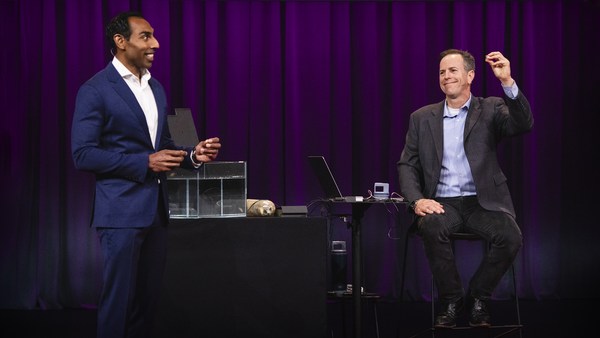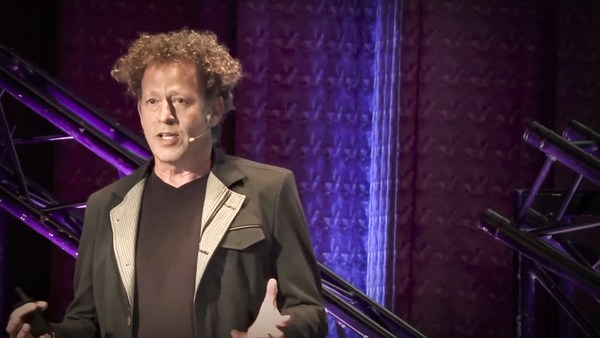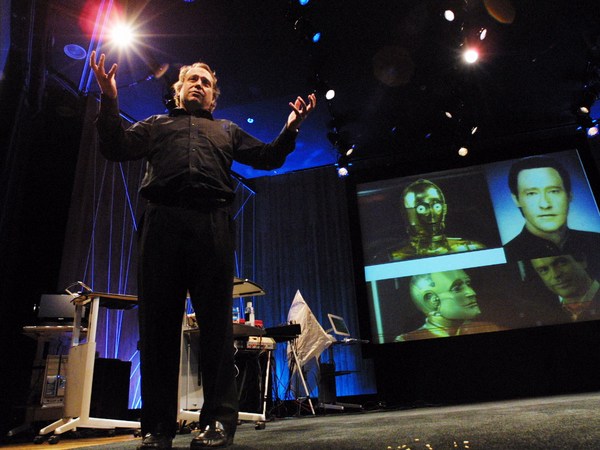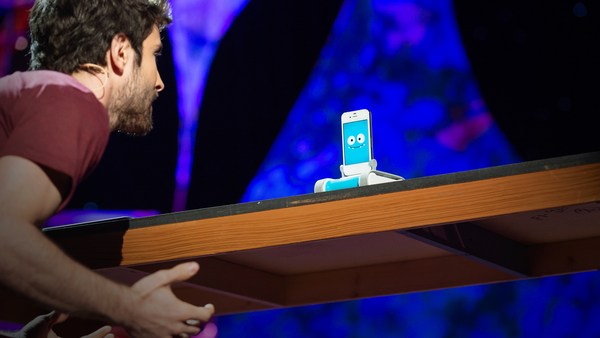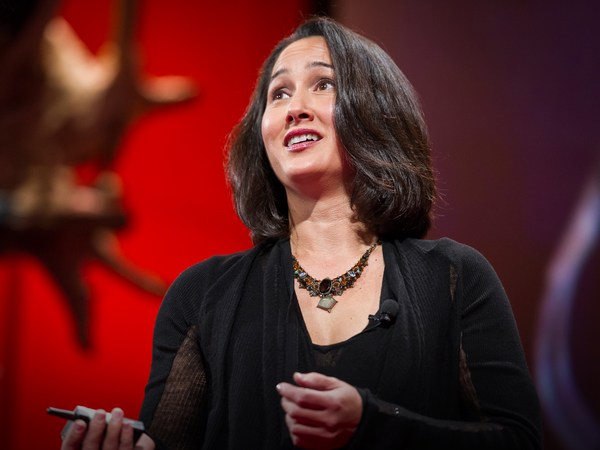(Applause)
NEO: As a species, humans have mastered energy to the level where it is, for all practical purposes, completely abundant. 200 years ago, no one could have imagined a world where energy was so accessible that most people would take it for granted. If you had asked the smartest person on Earth whether we could one day summon light with the flip of a switch, they would have said it was impossible. Even if the brightest minds worked on it together for an eternity. But today, it's just that easy. Energy is everywhere. All around us, all of the time.
Now what if I told you that the same is about to happen with labor? We are standing at the gates of a future where the work needed to build the products we use, the services we rely on and even the chores in our homes will be as effortlessly accessible as energy is today, enabling you to explore new frontiers and focus on what makes you truly human.
Thank you.
(Applause)
Bernt Børnich: Thank you, NEO. You're the best. It's an amazing machine, right?
Audience: Yeah.
(Applause)
BB: So I spent the last decade of my life working on building humanoid robots like NEO. Robots that will hopefully soon be able to do almost anything that we could imagine. Now whether this is helping you with the dishes, helping you do your laundry or whether this is helping your aging grandma, there's never really been a time better for robots. We have an aging population in need of help, and we have a large labor shortage across most of the global economy. And there's much, much more.
But even more importantly, to me, these robots, they promise something greater than just the ability to solve the problems of today. They can solve things that we cannot do today. They can give us back things like time. And as these systems and AIs now become both physical and agentic, we can start to work towards a future where we actually have an abundance of labor. We can start towards lifting humanity out of this constant battle over scarcity of resources, and create a world where everyone has what they need. And I think that will, to some extent, actually redefine what it means to be human.
But since I'd say, around year 1400, when Leonardo da Vinci made "The Mechanical Man," that to me is kind of like the first example of a humanoid robot, these things have been mainly a thing of science fiction, not reality. But this is changing. The robots, they're actually here. And when I say here, I don't necessarily mean in videos. They're actually here in our homes. At least if you work at 1X, where I work, where we now have them in quite a few homes throughout the company. And already later this year, I hope some of you guys will have it in your home and join us on this journey.
So that means NEO is now part of my daily routine. So it does some of the chores around the house. Some of this is autonomous. Some of this is done through remote operation as it's learning. And I talk to it. I treat it kind of like a butler, like a companion. It's part of the family. And I think it's actually incredibly interesting to also see how this social dynamic develops, because this is, of course, incredibly useful and fun to have it do stuff I don't want to do around my home. But it's also really fun to see the beginning of like, what will this relationship be between man and machine as these AIs become physical.
Now like I said, the hardware is actually here. It took us about a decade of very hard work, but also many people that came before us, a lot of time to do the foundational research for us to now finally be able to build a machine that can do almost anything that a human can do. But it begs the big question, of course: When will they be fully autonomous? When will they actually become truly intelligent? And what is the path that will actually take us there? And I think this will be very obvious in [retrospect]. They need to live and learn among us. We actually need to take these machines, and we need to adopt them. We need to put them into our society and let them learn just as we do.
So the general convention has been, or general wisdom, that robots, they're going to first happen in factories. So we're going to put these robots into factories, they're going to do the dull, repetitive, dangerous tasks that they're good at. And as they do these repetitive tasks, they get better and better, right? They get more intelligent. And after some time, we can put them into our home. They will be able to do our laundry, they will build our skyscrapers.
But this is actually categorically wrong. And we know because we actually tried that. So back in 2022, we took our previous generation wheeled humanoid, Eve, and we put it in industry. And it actually went really well. We solved a lot of kind of narrow, specific tasks, and it got really good at them really fast. And then after about 20 to 50 hours, the robots, they just stopped learning. And if you think about it, it's not really rocket science. Because if you’re doing the same task over and over every day, and it's the only thing you're doing, you're not going to get very intelligent. There's no information there. And also you're going to generally become very narrow-minded, right? We don't like being narrow-minded. And if you think about like, what is a factory? It is essentially a process that we design to reduce diversity and variance. You want your factory worker to need as little information as possible to be able to do the job and get a high-quality, repeatable product out. And this is kind of the opposite of what you need for intelligence. You need diversity, you need to challenge yourself. You need to do new tasks every day that you don't know how to do.
And there's a great parallel here to the early days of large language models. So when we use these models today, and they're getting really good, we kind of forget where they started. They started with a lot of people trying to make very narrow models. So if I take an example, if you wanted to make a very good writing assistant to write poetry, then you would, of course train on all of the best poetry in the world. Make sense. And then it wouldn't really work. And when we started training these models on all of the internet, right, the complete diversity of all human knowledge, they started working. They became kind of smart. They started being able to, to a certain extent, to reason. And I'd say like, understand to a certain extent, what is the question you’re asking and how should I answer. And this is also how we humans learn. We need a large amount of diversity for us to be able to develop into intelligent beings. So why should it be different for robots? And it really begs the question then: What is the equivalent of the internet? How do we find this kind of like internet-level diversity of information for our robots? Well we come to the conclusion that this is probably the home.
Now the home is this beautiful, chaotic thing. It's kind of like the messiness that is being human. And I want to take a small example here. So think about a cup. Now of course, there's many cups in the world, and you want to be able to figure out how all of them work. But even if you look at one specific cup, it can be so many things. Is it dirty? Is it clean? It's kind of in the middle? Is it on the table, in the cabinet, on the floor? It can even have a social context. Someone's using the cup. Someone's waiting for the cup. Like, why is the cup even there? And this is just a cup. Now think about expanding this out into everything and every object and everything going on in your home. That's the kind of diversity that we're talking about to get to proper machine intelligence.
So like any good scientist, right, we had this hypothesis, and now we have to test it. So in 2023, we brought our robots home. And I had Eve in my house for quite a while. And it was, of course, doing the standard things like emptying the dishwasher, but also bringing me a cup of tea when I was enjoying playing board games with my friends or serving cupcakes at my daughter's birthday party. And pretty quickly, it actually became quite clear that this hypothesis actually was the ground truth. The home is this incredible, diverse source of data that lets us continue to progress intelligence. So we thought originally that it was going to be this, but actually it was this.
And let me show you guys now how this actually works in practice. Oh thank you NEO, you’re doing a good job. It's a bit noisy, but hopefully you can still hear me. What you see here now, of course, is just a subset of tasks that NEO can do. And this is a mix of autonomy, for things the robot is good at, and some remote operation where someone's guiding the robot to basically do expert demonstrations on how to do these tasks. And as we have an increasing number of these robots throughout homes, living among us and learning, more and more of this becomes autonomous until hopefully, one day, all of this will be fully autonomous.
And if you kind of follow along in the field, a natural question to ask at this point would be: Why doesn’t everyone do this? If it's so obvious. Well it actually turns out, it’s incredibly hard to make a robot that is safe among people. So robots are traditionally these quite stiff, high-energy -- you’re doing great, NEO, you’re doing great. They're this -- careful, I don’t want to get watered -- stiff machines that are high-energy and dangerous. And this is very different from how NEO works. NEO actually has tendons that [get] pulled, very loosely inspired by human muscle. And this makes NEO into a robot that is quiet, soft, compliant, lightweight, safe, and really able to live among us and learn among us. Let's see if he figures it out. It's a hard one. You can do it, NEO.
(Applause)
I said he's the best, right? OK.
So this is still, of course, incredibly early. We're all the way in the beginning of this journey. But I do hope that, in not so long, just like we take energy for granted around us, we will be able to take labor around us for granted. And we might soon not even remember the day where there wasn't always like, a helping hand available for anything we wanted to do. But as these machines go around in our society and learn, to me this journey is about a lot more than just you not having to do your laundry. It's about creating a future where we actually have time to focus on what matters to us as humans, and getting rid of these constraints. But also, it's an opportunity to really have these machines help us solve some of the outstanding questions that we still have. Like, can we have robots build robots? Can we have robots build data centers to progress AI? Can we have robots that build chip fabs to help us accelerate adoption of AI? And I think it's getting pretty clear that we can have all of these things. But it goes even further than that. I hope we can get a future where we have humanoid robots like Neo that is actually building particle accelerators, that is building labs. We will have millions of robots around in the world doing high-quality, repetitive experiments in labs and helping us progress science at a pace that we have never seen before.
And I hope that in the future, through this kind of like a symbiosis between man and machine, we can start trying to answer some of the remaining big unanswered questions about the universe and our role here. And I think if we can do that, that will to some extent redefine what it means to be human.
Thank you.
(Applause)

